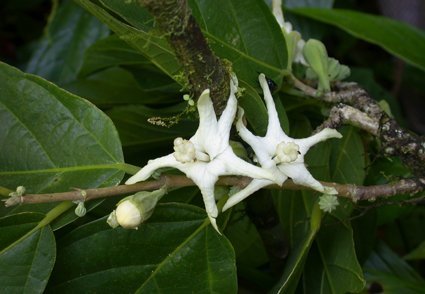Abstract
We describe Quararibea alversonii, a new species endemic to the Atlantic Forest of southern Bahia, which was found in the course of our review of Quararibea in Brazil. The new taxon is similar to Q. amazonica, mainly in calyx morphology, but it is distinguished by the presence of domatia, pedicel length, petal width, morphology of staminal columns and styles, as well as fruit shape. Here, we present a morphological description, taxonomic comments, photographs, distribution map, assessment of conservation status, and a comparative analysis between the new species and Q. amazonica, the only other member of the genus that also presents a costate calyx.
References
Alverson, W.S. (1989) Matisia and Quararibea (Bombacaceae) should be retained as separate genera. Taxon 38 (3): 377–388. https://doi.org/10.2307/1222268
Aublet, J.B.C.F. (1775) Quararibea. Histoire des Plantes de la Guiane Françoise 2: 691–694. https://doi.org/10.5962/bhl.title.674
Bachman, S., Moat, J., Hill, A.V., De la Torre, J. & Scott, B. (2011) Supporting Red List threat assessments with GeoCAT: Geospatial conservation assessment tool. In e-Infrastructures for data publishing in biodiversity Science. ZooKeys 150: 117–126. https://doi.org/10.3897/zookeys.150.2109
Bayer, C. & Kubitzki, K. (2003) Malvaceae. In: Bayer, C. & Kubitzki, K. (Eds.) Flowering Plants Dicotyledons. Springer, Berlin, 225–311. https://doi.org/10.1007/978-3-662-07255-4_28
Cascante-Marín, A., Sánchez-González, J. & Alverson, W.S. (2018) A New Quararibea (Malvaceae) from the Caribbean Lowlands of Costa Rica. Novon 26 (3): 262–267. https://doi.org/10.3417/2018106
ESRI (2013) ArcGIS for Desktop, v. 10.1. Redlands: Environmental Systems Research Institute.
Ferreira, C.D.M. (2019) Quararibea (Malvaceae) no Brasil extra-amazônico. M.Sc Thesis. Instituto de Pesquisas Jardim Botânico do Rio de Janeiro.
Ferreira, C.D.M. (2020) Quararibea in Flora do Brasil 2020. Jardim Botânico do Rio de Janeiro. Available from: http://reflora.jbrj.gov.br/reflora/floradobrasil/FB9199 (accessed 4 February 2022)
Ferreira, C.D.M. (2021) Quararibea bovinii (Malvaceae), a new species from the Brazilian Atlantic Forest. Rodriguesia 72: e01722019. http://dx.doi.org/10.1590/2175-7860202172015
Ferreira, C.D.M. & Bovini, M.G. (2020) Quararibea bragae (Malvaceae; Malvoideae): a new species with multiple domatia from Brazil. Phytotaxa 452 (3): 224–230. https://doi.org/10.11646/phytotaxa.452.3.5
Ferreira, C.D.M., Bovini, M.G. & Baumgratz, J.F.A. (in progress) Does Quararibea (Malvaceae; Malvoideae) have exclusive species from Cerrado Biome in Brazil? Untangling the taxonomy of Quararibea floribunda (A.St.-Hil. & Naudin) K. Schum. to solve this puzzle. Plant Ecology and Evolution.
Ferreira, C.D.M., Bovini, M.G. & De Toni, K.L. (2018) Miscellaneous additions to Quararibea (Malvaceae) from Atlantic Forest of Southeast Brazil. Systematic Botany 43 (4): 1011–1019. https://doi.org/10.1600/036364418X697616
Humboldt, F.W.H.A. & Bonpland, A.J.A. (1808) Plantae Aequinoctiales I. F. Schoell, Paris, 234 pp.
IUCN (2019) Guidelines for using the IUCN Red List Categories and Criteria, version 14. IUCN Red List Unit, Cambridge U.K. Available from: http://www.iucnredlist.org/ (accessed 5 February 2022)
O’Dowd, D.J. & Willson, M.F. (1989) Leaf domatia and mites on Australasian plants: ecological and evolutionary implications. Biological Journal of the Linnean Society 37: 191–238. https://doi.org/10.1111/j.1095-8312.1989.tb01901.x
Payne, W.W. (1978) A glossary of plant hair terminology. Brittonia 30: 239–255. https://doi.org/10.2307/2806659
Pittier, H. (1945) Notas dendrológicas de Venezuela. Boletin de la Sociedad Venezolana de Ciencias Naturales 10 (64): 107–115.
Poiret, J.L.M. (1816) Encyclopeìdie meìthodique. Botanique, Suppl. 4. Agasse, Paris, 731 pp. https://doi.org/10.5962/bhl.title.826
Radford, A.E., Dickison, W.C., Massey, J.R. & Bell, C.R. (1974) Vascular Plant Systematics. Harper & Row Publishers, New York, 891 pp.
Saint-Hilaire, A. (1825) Flora Brasiliae Meridionalis I. Apud A. Belin, Paris, 400 pp. https://doi.org/10.5962/bhl.title.45474
Schumann, C.K. (1886) Bombacaceae. In: Martius, C.F.P. von, Eicher, A.G. & Urban, I. (Eds.) Flora brasiliensis 12 (3). Monachii: Lipsitae, pp. 201–250. https://doi.org/10.5962/bhl.title.454
Swartz, O.P. (1788) Nova genera & species plantarum seu prodromus descriptionum vegetalium, maximam partem incognitorum quæ sub itinere in Indiam occidentalem annis. Uppsala & Abo, Stockholm, 152 pp. https://doi.org/10.5962/bhl.title.4400
Theobald, W.L., Krahulik, J.L. & Rollins, R.C. (1979) Trichome description and classification. In: Metcalfe, C.R. & Chalk, L. (Eds.) Anatomy of the dicotyledons. I. Clarendon Press, Oxford, pp. 40–53.
Thiers, B. (2022 [constantly updated]) Index Herbariorum: A global directory of public herbaria and associated staff. New York Botanical Garden’s Virtual Herbarium. Available from: http://sweetgum.nybg.org/science/ih/ (accessed 1 February 2022).
Ulbrich, E. (1908) Bombacaceae. In: Ule, E. Beiträge zur Flora der Hylaea nach den Sammlungen von Ule’s Amazonas-Expedition. Verhandlungen des Botanischen Vereins der Provinz Brandenburg 50: 90–91.


